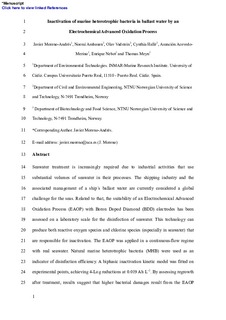| dc.contributor.author | Moreno-Andrés, Javier | |
| dc.contributor.author | Ambauen, Noemi | |
| dc.contributor.author | Vadstein, Olav | |
| dc.contributor.author | Halle, Cynthia | |
| dc.contributor.author | Acevedo-Merino, Asunción | |
| dc.contributor.author | Nebot, Enrique | |
| dc.contributor.author | Meyn, Thomas | |
| dc.date.accessioned | 2019-02-14T09:23:04Z | |
| dc.date.available | 2019-02-14T09:23:04Z | |
| dc.date.created | 2018-05-14T13:18:17Z | |
| dc.date.issued | 2018 | |
| dc.identifier.citation | Water Research. 2018, 140 377-386. | nb_NO |
| dc.identifier.issn | 0043-1354 | |
| dc.identifier.uri | http://hdl.handle.net/11250/2585389 | |
| dc.description.abstract | Seawater treatment is increasingly required due to industrial activities that use substantial volumes of seawater in their processes. The shipping industry and the associated management of a ship's ballast water are currently considered a global challenge for the seas. Related to that, the suitability of an Electrochemical Advanced Oxidation Process (EAOP) with Boron Doped Diamond (BDD) electrodes has been assessed on a laboratory scale for the disinfection of seawater. This technology can produce both reactive oxygen species and chlorine species (especially in seawater) that are responsible for inactivation. The EAOP was applied in a continuous-flow regime with real seawater. Natural marine heterotrophic bacteria (MHB) were used as an indicator of disinfection efficiency. A biphasic inactivation kinetic model was fitted on experimental points, achieving 4-Log reductions at 0.019 Ah L−1. By assessing regrowth after treatment, results suggest that higher bacterial damages result from the EAOP when it is compared to chlorination. Furthermore, several issues lacking fundamental understanding were investigated such as recolonization capacity or bacterial community dynamics. It was concluded that, despite disinfection processes being effective, there is not only a possibility for regrowth after treatment but also a change on bacterial population diversity produced by the treatment. Finally, energy consumption was estimated and indicated that 0.264 kWh·m−3 are needed for 4.8-Log reductions of MHB; otherwise, with 0.035 kWh·m−3, less disinfection efficiency can be obtained (2.2-Log red). However, with a residual oxidant in the solution, total inactivation can be achieved in three days. | nb_NO |
| dc.language.iso | eng | nb_NO |
| dc.publisher | Elsevier | nb_NO |
| dc.rights | Attribution-NonCommercial-NoDerivatives 4.0 Internasjonal | * |
| dc.rights.uri | http://creativecommons.org/licenses/by-nc-nd/4.0/deed.no | * |
| dc.title | Inactivation of marine heterotrophic bacteria in ballast water by an Electrochemical Advanced Oxidation Process | nb_NO |
| dc.type | Journal article | nb_NO |
| dc.type | Peer reviewed | nb_NO |
| dc.description.version | acceptedVersion | nb_NO |
| dc.source.pagenumber | 377-386 | nb_NO |
| dc.source.volume | 140 | nb_NO |
| dc.source.journal | Water Research | nb_NO |
| dc.identifier.doi | 10.1016/j.watres.2018.04.061 | |
| dc.identifier.cristin | 1584845 | |
| dc.description.localcode | © 2018. This is the authors’ accepted and refereed manuscript to the article. Locked until 3.5.2020 due to copyright restrictions. This manuscript version is made available under the CC-BY-NC-ND 4.0 license http://creativecommons.org/licenses/by-nc-nd/4.0/ | nb_NO |
| cristin.unitcode | 194,64,91,0 | |
| cristin.unitcode | 194,66,15,0 | |
| cristin.unitname | Institutt for bygg- og miljøteknikk | |
| cristin.unitname | Institutt for bioteknologi og matvitenskap | |
| cristin.ispublished | true | |
| cristin.fulltext | preprint | |
| cristin.qualitycode | 2 | |

